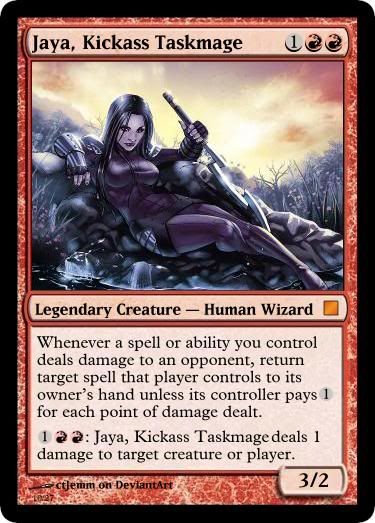Another example is the effect of destroying a tapped creature or attacking creature. That limitation makes it defensive/retributive in nature, making it fit into white. Bouncing an opponent's creature, especially at sorcery speed, is red since it is an offensive application of the effect. I think it could be used more.
A second way of making an effect fit into another color is to tack an extra ability onto it. Black doesn't usually damage creatures outright, and never gains life as a stand-alone effect. But because of the flavor of "feeding off of the misery of others," it can have both of these if it gains life off of damage. This is more of an aesthetic reason rather than any kind of game balance consideration.
So with these two types of ability-shifting in mind, I think red could have a counterspell like this:
I think this "Venser" ability feels like a red way of countering spells because it throws away card advantage for a temporal gain. By tacking damage onto the effect, it would be playable even when it is less efficient (as well as card-disadvantageous) compared to blue counters. It wouldn't just be a worse counter, it would be a different counter.
Maybe this ability could be called a "distraction" "daze" or "stun" effect.
One possible problem with this effect is that it could be too devastating for slow decks that utilize lots of midrange permanents rather than spells.
I understand that during Planar Chaos, WotC considered moving Memory Lapse into white, but testing showed that a white delay spell would be too good in the weenie swarm color that white is. The card above might present the same problem (although it suffers card disadvantage that Memory Lapse doesn't have) since red is even more aggressive than white.
But it could be a matter of adjusting the cost; Memory Lapse had to remain at the same cost because it was being considered as a colorshifted card.
A second problem is that it's kind of wordy. The text could be simpler if it just returned a spell to its owner's hand instead of acting like a mana leak. However, I think having a number involved (like "pay 2") can help connect the spell-bouncing effect with the flavor of "interrupting a spell with a painful blow" better.




Awesome work. I love your reasoning and I find Stunning Bolt and Taskmage lacking any major issues at first blush. It'll take some players longer than others to accept the concept of a "red counterspell" but the distracting-damage flavor is compelling as is the game-play. Playtesting these will make or break the whole deal.
ReplyDeleteI agree with Jay that you did an excellent job rationalizing this concept as appropriately Red, serving as a good addendum to the discussion occurring in comments for Jay's NPH-Red analysis. One concern here, relative to Luminum's response to my own thoughts for expanding Red's repertoire, is that bouncing spells definitely feels unsuited to common spells, even if it's by-and-large just a Memory Lapse effect. Of course, this may just be a case of saying that it would simply use a portion of a given set's complexity points to try and allow the playerbase to grow accustomed to the terminology/rules associated with the effect.
ReplyDeleteAlso, don't forget that they did actually move Memory Lapse to white. It was printed in Conflux, where it was absolutely unplayable.
Yeah, at first I posted it as an uncommon. (That's the version Jay commented on when he said he saw no problem.) But then I got ambitious and changed it to common.
ReplyDeleteI don't know if bouncing a spell would feel complex for a new player or not. It could just be that we find it weird because we're used to Magic and we don't see that effect very often.
However, it's true that this effect requires the player to have at least some vague idea that a spell goes somewhere before it is resolved (even if s/he doesn't know the word "stack"), otherwise the word "return target spell to hand" might not make intuitive sense to them as ordinary English, whereas "counter target spell" does make sense as ordinary English. People might think of returning a spell from the graveyard and be confused why someone would do it for an opponent.
I forgot about the white Memory Lapse. Thanks for pointing that out.
Nice idea! At one point I was thinking of writing an article on spreading interactions "on the stack" to all colors, the same way that all colors can participate in combat. One of the biggest issues with strong countermagic is that there is no way for non-Blue decks to interact with it. Red does already have cards like Wild Ricochet and Radiate, and ideas like this could make sense. Taxing effects are more White than Red, however.
ReplyDeleteThe problem with doing anything with "on the stack" is the issue of many players not being familiar with the stack at all. As simple as it might seem to someone well-versed in the rules there's a reason why Wizards has said time and again that it's not all that commonly understood, which is the reason involvement in the stack is only sparingly used.
ReplyDeleteLuminum Can - I wasn't suggesting referencing the stack. I was referring to spells that affect things which are on the stack. Wizards doesn't appear to have a major problem with printing such cards in principle, as they put one or more common counterspells into every set.
ReplyDelete